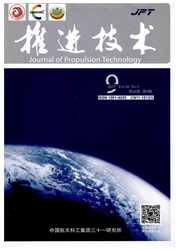

 中文摘要:
中文摘要:
高马赫数下超燃冲压发动机煤油再生冷却过程中易发生热裂解反应导致结焦,因此有必要在冷却通道中开展热裂解过程研究.基于热裂解反应产物试验结果建立了一步热裂解总包反应,对煤油在冷却槽道中超临界流动换热以及热裂解过程展开了三维数值模拟研究,将固壁的传热和槽道内流动反应进行耦合计算,与三种不同热流密度的实验工况对比.结果表明,在热裂解反应发生以前,两相流模型的温度分布和实验数据吻合得很好,但随着燃油温度升高到450℃,燃料开始发生复杂的化学反应,两者开始出现偏离,温度越高,偏离越大.在引入热裂解反应模型之后,高温区域的温度显著降低,和实验结果吻合.热流密度越大,裂解反应率加剧,煤油反应转化率增大.煤油在弯折冷却通道中温度分布不对称.
 英文摘要:
英文摘要:
Thermal cracking is easy to cause the coking during the regenerative cooling process in the high Mach number scramjet.It is necessary to study the thermal cracking behavior in the cooling channel.A one-step thermal cracking global reaction was established based on the experimental results of reaction products.Using the global reaction kinetics a 3 D numerical simulation of thermal cracking coupled with twophase flow and heat transfer was carried out in a cooling rectangular channel.Three cases of different heat fluxes were compared between the simulation and experiments.The results show that wall temperature distribution of the simulation only using two-phase model are in good agreement with the experiment data before the thermal cracking reaction.There is an obvious difference between the simulation and experiment when fuel temperature increases above 450℃.The higher the fuel temperature is,the bigger the difference is.The wall temperature of the simulation after introducing thermal cracking model decreases and agrees well with the experimental results.When heat flux increases,the cracking reaction rate and conversion rate of kerosene grow.The temperature distribution of kerosene in a curved channel is asymmetric.
 同期刊论文项目
同期刊论文项目
 同项目期刊论文
同项目期刊论文
 期刊信息
期刊信息
